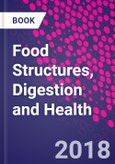This selection of key presentations from the Food Structures, Digestion and Health conference is devoted to the unique and challenging interface between food science and nutrition, and brings together scientists across several disciplines to address cutting-edge research issues. Topics include modeling of the gastrointestinal tract, effect of structures on digestion, and design for healthy foods.
New knowledge in this area is vital to enable the international food industry to design of a new generation of foods with enhanced health and sensory attributes. The multidisciplinary approach includes research findings by internationally renowned scientists, and presents new research findings important and pertinent to professionals in both the food science and nutrition fields.
Table of Contents
Section 1: Understanding food structures in natural and processed foods and their behavior during physiological processing 1. Understanding food structures: The colloid science approach 2. Processing of food structures in the gastrointestinal tract and physiological responses 3. The basis of structure in dairy-based foods: Casein micelles and their properties 4. The milk fat globule membrane: Structure, methodology for its study and functionality Section 2: Impact of food structures and matrices on nutrient uptake and bioavailability 5. Exploring the relationship between fat surface area and lipid digestibility 6. Protein polysaccharide interactions and digestion of the complex particles 7. Muscle structure and digestive enzyme bio-accessibility to intracellular compartment 8. Cotyledon cell structure and in vitro starch digestion in navy beans Section 3: Modelling the gastrointestinal tract 9. Mathematical models of food degradation in the human stomach 10. An improved understanding of gut function through high-resolution mapping and multiscale computational modelling of the gastrointestinal tract 11. Novel approaches to tracking the breakdown and modification of food proteins through digestion 12. Dynamics of gastric contents during digestion-computational and rheological considerations Section 4: Food developments to meet the modern challenges of human health 13. Applying structuring approaches for satiety: Challenges faced, lessons learned 14. Technological means to modulate food digestion and physiological response 15. Describing dietary energy Towards the formulation of specialist weight-loss foods 16. Combined phytosterol and fish oil therapy for lipid lowering and cardiovascular health 17. Dairy materials as delivery tools for bioactive components in dairy platforms 18. The importance of microbiota and host interactions throughout life








